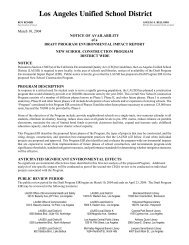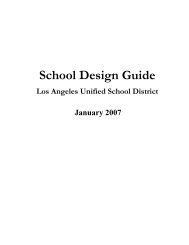Site-Specific Health and Safety Plan (HASP) - Laschools.org
Site-Specific Health and Safety Plan (HASP) - Laschools.org
Site-Specific Health and Safety Plan (HASP) - Laschools.org
You also want an ePaper? Increase the reach of your titles
YUMPU automatically turns print PDFs into web optimized ePapers that Google loves.
LAUSD Proposed South Region High School #9 & Middle School #4<br />
6-7<br />
December 2006<br />
<strong>Site</strong> <strong>Specific</strong> <strong>Health</strong> & <strong>Safety</strong> <strong>Plan</strong> (<strong>HASP</strong>)<br />
interrupters, grounding, extension cords, <strong>and</strong> tool inspection procedures; <strong>and</strong> employee<br />
training <strong>and</strong> PPE requirements.<br />
• Process <strong>Safety</strong> Management. At process sites where highly hazardous chemicals are<br />
stored or used, comply with special considerations <strong>and</strong> process safety management<br />
OSHA regulations.<br />
• Traffic Controls. Control measures include warning signs, flagmen, traffic stoppage <strong>and</strong><br />
control, <strong>and</strong> unloading procedures. Internal traffic control plans should include ways to<br />
restrict the number of vehicles on site, the flow of vehicles accessing the site <strong>and</strong> driving<br />
through the site, haul roads, speed controls, subcontractor employee parking areas,<br />
merging of site traffic with local vehicle traffic, pedestrian controls in traffic zones,<br />
access by emergency <strong>and</strong> rescue vehicles <strong>and</strong> operator controls.<br />
• Vehicle Operation. Although driving a vehicle may be second nature to many<br />
individuals, there are many hazards <strong>and</strong> controls that need to be identified. Fatigue <strong>and</strong><br />
distractions are two hazards that many individuals do not think about on a regular basis.<br />
Operating off-road vehicles such as an All-Terrain Vehicle (ATV) also require training.<br />
• Work Near/On Water. Analyze work hazards on a marine vessel (i.e. barge, dredge,<br />
pontoon boat, etc) or adjacent to (within 4 feet), in, or over water (including lakes, canals,<br />
dams, treatment plants, water tanks, clarifiers, <strong>and</strong> reservoirs).<br />
Exhibit 6-1 is a sample activity hazards analysis form. Exhibit 6-2 shows a training record to be<br />
completed <strong>and</strong> kept on file for each activity hazards analysis.<br />
6.3.1 Chemical Hazards<br />
A table of potential chemical hazards at the <strong>Site</strong> <strong>and</strong> their chemical properties is in Table 6-1.<br />
Chemical compounds at the <strong>Site</strong> may include, but may not be limited to, the listed compounds.<br />
6.3.2 Physical Hazards<br />
In addition to the hazardous substances potentially present at the <strong>Site</strong>, other physical hazards or<br />
hazardous conditions may be expected during the course of performing fieldwork, including<br />
excavation <strong>and</strong> data collection. As described above, these hazards include possible risks from<br />
injury while working around heavy, stationary or moving equipment; slip, trip, <strong>and</strong> fall hazards;<br />
excessive noise conditions; fire or explosion hazards; subsurface/excavation hazards; electrical<br />
hazards; electric power line clearance; heat stress; <strong>and</strong> urban violence <strong>and</strong> stray animals.<br />
The guidelines presented in this section are applicable to general types of equipment that may be<br />
used during this investigation. Individual equipment types or certain specialized equipment may<br />
require additional safety considerations or specialized training prior to its use. Should any<br />
specialized equipment be required during the performance of a task, the SHSO will ensure that<br />
operators receive appropriate training. The SHSO also will be responsible for ensuring that all<br />
equipment is routinely inspected <strong>and</strong> that any piece of equipment considered unsafe is not used<br />
until the unsafe conditions are corrected or repaired.<br />
198







